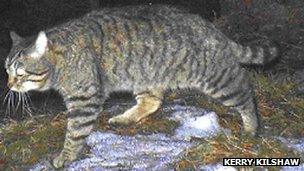Further Scottish wildcats snow studies possible
- Published

Scottish wildcats' paws might not be well suited to dealing with deep snow
A scientist researching Scottish wildcats said further studies of the animals' behaviour in deep snow could be carried out in the future.
Wildcats may have trouble crossing deep snow, as camera traps set in the Cairngorms last year captured no images of the animals after heavy snowfalls.
Other predators such as pine martens were photographed in thick snow.
Kerry Kilshaw, who worked on the project, said further research in the conditions may follow later.
Twenty camera traps were set up at locations on the Seafield and Strathspey Estates in the Cairngorms National Park between February to May 2010.
Scottish Natural Heritage (SNH) published a report, external on the project's findings last year.
SNH and University of Oxford's Wildlife Conservation Research Unit (WildCRU) worked together on the research.
More than 3,000 photographs were taken, with 1,019 showing wildlife.
Twenty-seven different species were identified, including capercaillie and tawny owls. Rabbits were the most frequently seen animal.
Thirteen "wild-living" cats were photographed during the study, with four of them identified as wildcats.
The other nine were thought to be hybrids, rather than pure Scottish wildcats.
'Body weight'
Among the study's findings was a suggestion that the cats avoided crossing deep snow.
Ms Kilshaw, who has been involved in projects at WildCRU on small carnivores since 2003, said there were two possible reasons for this.
The biologist told the BBC News Scotland website: "The first is simply a question of morphology.
"Cats in general have small paws in relation to their body weight compared to a pine marten for example which has slightly larger feet - especially the back feet - so it is easier for the animal to spread its weight across the snow and therefore move faster and more quietly.
"So I think wildcats would just find it easier to move around under the tree cover where snow will be shallower during heavy snowfall, which is why I suspect we didn't get them on camera during very heavy snowfall, but did get things like pine marten.
"I think they simply went somewhere else.
"Another reason is that it would be harder for cats to hunt voles, which move around under the snow, stealthily because they would be heard."
Ms Kilshaw, whose previous research work has included studies of brown hyenas and caracals in Africa, said the cats were likely to be using their energy efficiently by avoiding deep snow.
- Published2 January 2012
- Published28 September 2011
- Published25 August 2011
- Published14 October 2010
- Published18 August 2010
- Published17 July 2010